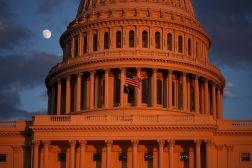Government agencies warming more to cloud
Rep. Will Hurd, the chairman of the House Oversight and Government Reform IT Subcommittee, has recently been prodding the federal government to move quicker on the cloud.
Interviews with a number of federal analysts over the past few days suggest that Hurd may get his wish, as long as he isn’t specifically talking about public cloud.
As the fiscal year comes to a close, analysts told FedScoop that agencies are furthering their use of cloud, figuring out ways to move past the testing or pilot phases and into a footprint that relies on cloud services for day-to-day operations.
“The volume of conversation we are having about cloud with government agencies is at the same level or higher with our commercial clients,” said Dan Helfrich, federal civilian sector leader for Deloitte. “We are definitely seeing a fairly informed government buyer talking about the right thing.”
Those conversations are leading to agency purchases, he said, but only after they’ve done their due diligence on what exactly it is they are looking to get out of the cloud.
“The pace at which those conversations are translating to massive cloud migration programs is more methodical,” Helfrich said. “Protection of data and security are critical parts of those conversations. Government organizations are still trying to navigate the trade-offs between efficiency and security, and trying to find the right balance.”
Prince Anand, director and general manager of federal sales at Insight, told FedScoop that balance does not include public cloud offerings.
“Agencies are not going to public cloud,” Anand said. “They push back hard when someone like Microsoft says, ‘We’ve built a separate cloud for government agencies.’ They will go to lengths to say ‘No, we don’t want to be there with anybody else.’ They want their own separate carved out piece.”
He said part of that pushback comes from having to consolidate systems on a public cloud, while things can be compartmentalized as CIOs see fit in their private cloud or managed data centers.
“With virtualization and consolidations, you have information that you have consolidated together,” Anand said. “If you have a breach, you don’t have a small breach. You add the further phenomenon of multiple devices per user, and it further adds complexity.”
This mirrors what Mark Kneidinger, director of federal network resilience for the Department of Homeland Security, told Hurd in San Antonio last week: Agencies remained worried about ceding the power to control their own hardware and infrastructure.
The concern “is driven by the ability to have a degree of awareness as to the level of security that’s provided at the cloud level, and the visibility the agency has to make sure they are meeting their responsibility for securing their assets,” Kneidinger said.
Despite the temerity with public cloud, agencies have increased their spend. According to business intelligence firm Govini, cloud spending nearly tripled in fiscal year 2014 from fiscal 2013, with another increase expected in fiscal 2015.
Govini found four software-as-a-service areas where the money is flowing: Office productivity, customer relationship management, financial software and software-defined data services. Office productivity spend has increased 73 percent from fiscal 2011 ($577 million) to fiscal 2014 ($1 billion), buoyed by Lockheed Martin’s office automation contract with the Federal Aviation Administration and AT&T’s contract with the Navy’s NGEN network.
Anand said he is seeing a lot of movement toward Microsoft Office 365 as a way for agencies to ease into the cloud.
“There is a struggle with consolidation first” he said, adding that Office 365 allows agencies to “get it to a point where you can turn the switch and go to the cloud one day.”
Helfrich said office productivity is just one portion of the buys he is hearing about.
“The variety of cloud is significant,” he said. “It’s not just email.”
Regardless of the kinds of cloud, Helfrich said that service providers have been “active” in the government space.
“We view that as a positive sign that the government is getting serious about taking advantage of the efficiency and effectiveness that cloud could provide.”






